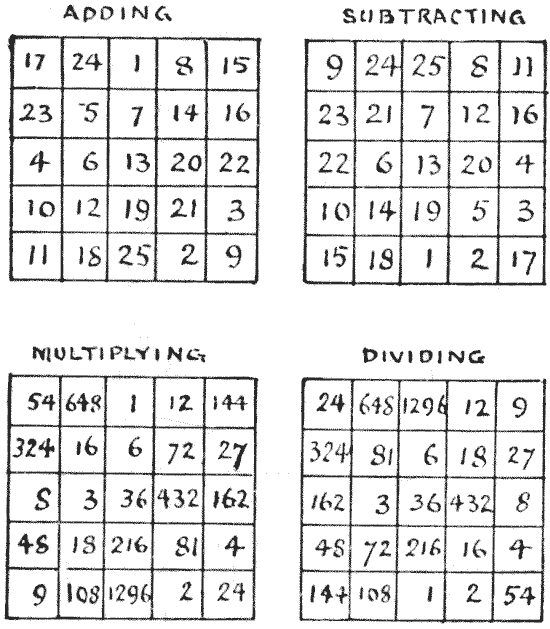Although the adding magic square is of such great antiquity, curiously enough the multiplying magic does not appear to have been mentioned until the end of the eighteenth century, when it was referred to slightly by one writer and then forgotten until I revived it in Tit-Bits in 1897. The dividing magic was apparently first discussed by me in The Weekly Dispatch in June 1898. The subtracting magic is here introduced for the first time. It will now be convenient to deal with all four kinds of magic squares together.

In these four diagrams, we have examples in the third order of adding, subtracting, multiplying, and dividing squares. In the first, the constant $15$ is obtained by the addition of the rows, columns, and two diagonals. In the second case you get the constant, $5,$ by subtracting the first number in a line from the second, and the result from the third. You can, of course, perform the operation in either direction; but, in order to avoid negative numbers, it is more convenient simply to deduct the middle number from the sum of the two extreme numbers. This is, in effect, the same thing. It will be seen that the constant of the adding square is $n$ times that of the subtracting square derived from it, where $n$ is the number of cells on the side of the square. And the manner of derivation here is simply to reverse the two diagonals. Both squares are "associated" — a term I have explained in the introductory article to this department.
The third square is a multiplying magic. The constant, $216,$ is obtained by multiplying together the three numbers in any line. It is "associated" with multiplication, instead of by addition. It is here necessary to remark that in an adding square it is not essential that the nine numbers should be consecutive. Write down any nine numbers in this way— $$\begin{array}{ccc} 1& 3& 5\\ 4& 6& 8\\ 7& 9& 11\\ \end{array}$$ so that the horizontal differences are all alike and the vertical differences also alike (here $2$ and $3$), and these numbers will form an adding magic square. By making the differences $1$ and $3$ we, of course, get consecutive numbers — a particular case, and nothing more. Now, in the case of the multiplying square, we must take these numbers in geometrical instead of arithmetical progression, thus—
$$\begin{array}{ccc} 1& 3& 9\\ 2& 6& 18\\ 4& 12& 36\\ \end{array}$$
Here each successive number in the rows is multiplied by $3,$ and in the columns by $2.$ Had we multiplied by $2$ and $8$ we should get the regular geometrical progression, $1, 2, 4, 8, 16, 32, 64, 128,$ and $256,$ but I wish to avoid high numbers. The numbers are arranged in the square in the same order as in the adding square.
The fourth diagram is a dividing magic square. The constant $6$ is here obtained by dividing the second number in a line by the first (in either direction) and the third number by the quotient. But, again, the process is simplified by dividing the product of the two extreme numbers by the middle number. This square is also "associated" by multiplication. It is derived from the multiplying square by merely reversing the diagonals, and the constant of the multiplying square is the cube of that of the dividing square derived from it.
The next set of diagrams shows the solutions for the fifth order of square. They are all "associated" in the same way as before. The subtracting square is derived from the adding square by reversing the diagonals and exchanging opposite numbers in the centers of the borders, and the constant of one is again $n$ times that of the other. The dividing square is derived from the multiplying square in the same way, and the constant of the latter is the $5$th power (that is the nth) of that of the former.

These squares are thus quite easy for odd orders. But the reader will probably find some difficulty over the even orders, concerning which I will leave him to make his own researches, merely propounding two little problems.
This eBook is for the use of anyone anywhere in the United States and most other parts of the world at no cost and with almost no restrictions whatsoever. You may copy it, give it away or re-use it under the terms of the Project Gutenberg License included with this edition or online at http://www.gutenberg.org. If you are not located in the United States, you'll have to check the laws of the country where you are located before using this ebook.